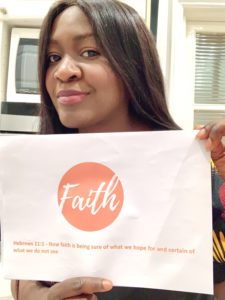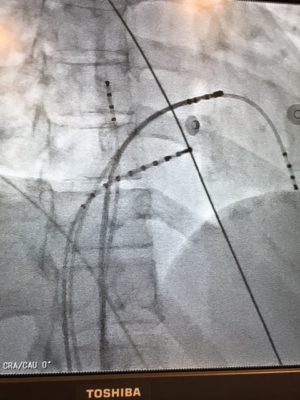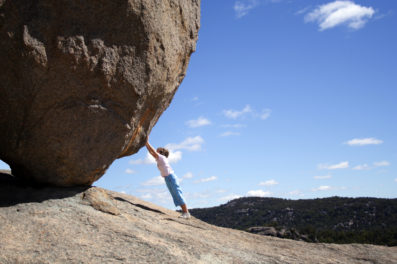(originally published in The Purple Fig, written by Nikki Bergen)

The following is an interview with Belle student Kathleen Henderson. Kathleen joined our weekly BelleFusion classes over one year ago while in the middle of treatment for breast cancer. That first day she walked into the studio – timid yet quietly determined, cap on her head – I saw her incredible bravery.
This mom of four was diagnosed at the age of 38, when her twins were just 16-months old and her older children 5 and 7. I’ve been privileged to watch Kathleen progress in class and honoured to be a small part of her recovery. She’s a true and humbling inspiration to me. This interview is my attempt to share her story and hopefully inspire and encourage other women experiencing the trauma and fear of cancer.
I know it can be emotional to relive the events in your head. Thank you for doing this. Could you please tell us the story of your diagnosis?
I actually brought myself to the doctor because I felt something was wrong. There was a sizeable thickening in my right breast that was very painful. At first I thought it might be related to having just finished nursing the twins, but my gut told me to get it checked out. My doc recommended a mammogram right away. They phoned 24 hours later with the news this was cancer and it “… seems unlikely that it isn’t invasive”. I had stage 1A cancer in the milk ducts and the initial treatment would be a full right mastectomy and lymph node removal. Due to the confirmation of the invasive nature of the cancer and my Her2 positive status, I also underwent 6 rounds of chemotherapy, 25 rounds of radiation, and a year of Herceptin injections.
It just goes to show that women need to trust their instincts and get checked out, even if they’re told “it’s probably nothing.” I had no idea that I was in the running for breast cancer. Check yourself out – don’t talk yourself out of it. And if you still have a concern and your doctor says it’s nothing, go back. Follow your gut.
So you had surgery right away and then rehab?
Yes. After the surgery in November, nurses gave me specific exercises to help with range of motion. You’re told to do them as soon as you can move after the operation. They set me up to meet one time with the hospital physiotherapist. I did the exercises religiously, as instructed. I understood how important they would be to my recovery. Throughout my life, I have been told, “Kathleen, you’re so strong”, and returning to a physical sense of strength was important for me to maintain as part of my identity.
Surgery was in November 2013 and you first came to class in March 2014, just 14 weeks later. Did you have any fears about joining a regular group exercise class?
I remember being petrified thinking “now I’m going to have to take my hair off and put my cap on.” I was so self-conscious, mortified. It was intimidating. Then I thought well, that’s stupid. As soon as I walked in, I liked the vibe of the class.
I had no idea! You seemed so quietly confident when you walked into class for the first time. How did the classes help?
They helped me a lot. They helped me re-establish a positive connection with my body. Everything about having breast cancer is negative – this terrible invasive thing is happening to your body and you have very little control over it.
It was good to go in and work hard, and be able to work hard. It’s like hey, these bad things have happened but I can do this. I could keep up. I’m a pretty active person so I needed to stay active – it’s something I’ve done my whole life. The classes were both a physical and mental help. Sometimes the class was really hard but the mental part of it was, “I CAN do this,” and the endorphin release was key.
How did you stay so mentally determined and positive?
In the grand scheme of the whole experience, this was “better than nothing”. I kept telling myself “it’s ok, I’m trying”. When I was walking slowly around High Park, barely able to move, at least it was “BTN, better than nothing. I’m doing the best I can with this bad situation”.
Sometimes you feel a bit ripped off. Why did this have to happen? I’m 38 years old, why do I have to my own cheerleader and give myself a pep talk just to go for a walk? But, in the end, I am proud of the way I managed it. I realized how important it is for me to remain positive to be able to make the best of this day. The idea of that strength is part of my identity and in retrospect, I think I stayed true to who I am.
That’s an interesting phrase “I have to be my own cheerleader”
I think everyone does, and that’s ok. The key is that for some people how I’ve done some things, wouldn’t work for them. You have your own worldview, your own identity. I didn’t spend too much time thinking about how to approach it. I had always been strong, and I had to keep that intact. For example, for women who have always defined themselves as “creative”, they might have a different and equally effective way of coping.
What advice would you give to other women reading this who are going through the same thing?
It is very difficult for women of our generation to be vulnerable or to need help. We have grown up in an era where we are doing it all. I would say you should try to allow people to do for you. Not because you can’t do it, but because they want to show their love.
Have the grace to accept their dinner, to accept their love. I’m going to take their dinner and be graceful in accepting it. You don’t have to prove that you can do things. Be open. Be open to the fact that people don’t know what to do. They’re not trying to hurt you. Maybe they’re out of touch for 3 weeks because they don’t know what to say. Allow for people to not be their best. Eventually they come around. This sounds awful, but I felt that I was their worst nightmare – I imagined that all the dads in our neighbourhood couldn’t look me in the eye at first because I represented the worst thing that could happen to their wives. In retrospect, maybe they were trying to keep a respectful distance, so they just nodded as I walked by.
But people do want to help. I had a cooler on my front porch and everyday for months our family had dinner dropped off through a program called Meal Train. Our neighbours and friends signed up online and took turns. It was a huge gift and a great way for a community to rally and help someone.
Wow, that’s a really cool program.
Yes it was. Our friends organized it for us. It allowed us to focus our best efforts on being together with our children instead of worrying about how to feed our family of 6.
Do you have any other advice?
One other thing that someone told me regarding how people react to cancer – often parents and siblings and friends don’t know what to do. Picture a bull’s eye graphic and the centre is the sick patient. The next circle around is your husband, sister or mom. The next circle is your best friend. The next circle contains more extended family, friends, coworkers etc. Supporters need to find someone less connected to talk to. So it needs to move away from me. My sister can’t come to me sharing her fears about my cancer. She needs to talk to her friends or husband about that. The sick person in the middle shouldn’t have to deal with quelling their concerns. I had to explain that to my family and once they understood that, it really helped.
How has this experience of cancer changed your outlook on life and on motherhood?
Being diagnosed with breast cancer was a loss of innocence, of expecting good things to happen to good people. All of a sudden you realize all the things you’ve imagined just may not be. I’ve been given so much love and opportunity. I’ve been walking through life with all these really small problems and now I have a really big problem. It’s a mental exercise to process it. My life may not be the life I imagined. There’s a darker side to it. You also have this sense regarding those old problems, that they really don’t matter as much.
I knew there was going to be emotional fallout. All of a sudden the chemo is done and you start to think about what happened because you have time, you’re not rushing to appointments. I called it the reckoning. When it happened to me, I was beside myself for 3 weeks and it was very hard.
As for motherhood, once my energy returned and I was able to be more present for my kids, I realized that I appreciate things differently. You know more in a really sad way – you know more about life. It takes a lot more to make me upset with them now. Because it really doesn’t matter. I’m much more laid back now. Focusing more on fun. My kids aren’t going to not go to university if we take a trip to Antigua. And that time is important for a couple also – so we did go!
How important was exercise to your for your recovery?
It was crucial. I had to move. I remember running in High Park and bawling. Some people saw me…they must have thought I was crazy. I was crying because 6 months earlier I could barely walk, and now I was running up that damn hill.
I turned to exercise all the time. Even if you feel bad, you’re going to feel better. If you’re feeling really awful mentally, at least you can physically feel better and remind yourself that your body is still strong.
How to feel about being called a hero?
No! For my recent 40th birthday, my good friend got me a necklace that says “survivor, hero, role model”. I can’t handle that. People talk about being a survivor. They are such loaded words. I think those words should be chosen by people for themselves. So no, I’m not a hero. I just tried to stay alive for my own selfish reasons and did what the doctors told me to do. Why do I get a prize for having a really bad thing happen to me? I’m not Mother Theresa. I don’t want people to feel like they have to be “that.” Figure out who you are in this part of your life and be true to that. Sit with what’s happening, and sort out how you want to deal with it. Define how you’re going to do it and stay true to yourself.
This has been pretty emotional, so thank you again for sharing with me today and allowing other women to hear your story. Your honesty is going to inspire a lot of people. Now go enjoy a glass of Chardonnay on your deck!
Oh (laughing)! I’m already there Nikki!
KH
























